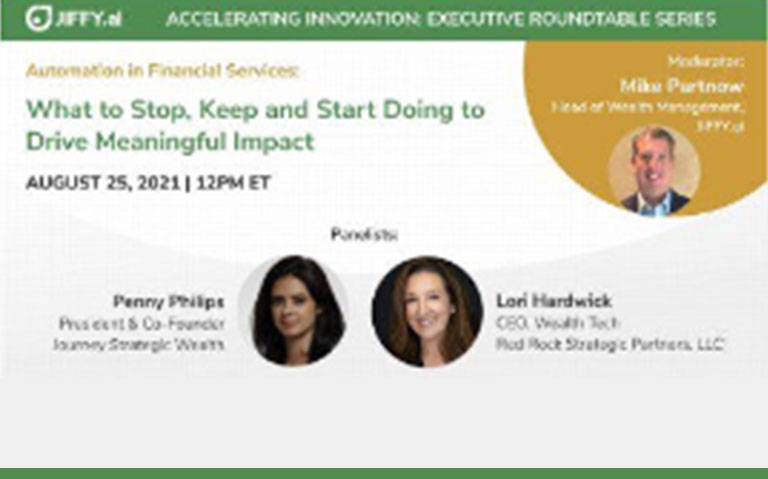
JIFFY.AI's Panel Discussion: "Automation in Financial Services"

Most Recent Insights
The latest articles, events, podcasts, panels, presentations, videos and resources from our team.

2026 Federal Tax Changes & Planning Guide
Advisor Edition*As of October 2025 Turning Tax Changes into Opportunity The IRS has released its official 2026 tax brackets and related updates, reflecting both routine inflation adjustments and several new deductions introduced under the One Big Beautiful Bill (OBBB) legislation.For advisors, 2026 will mark one of the most consequential mid-cycle shifts in individual and small-business taxation since the 2017 Tax Cuts and Jobs Act. This guide summarizes the key provisions, who they impact, and how to translate them into actionable planning opportunities.The focus here is tactical, not theoretical—specific actions you can take before year-end 2025 and discussion points to raise proactively in early 2026. 1. Core Bracket & Deduction Changes Higher thresholds. Larger deductions. Expanded planning flexibility.Inflation adjustments for 2026 expand nearly every federal income tax bracket. Most households will see slightly lower effective tax rates, but proactive modeling is essential, especially for clients near bracket thresholds or those timing income and deductions between tax years. RateSingle (2026)Married (2026)% Change from 2025Advisor Note10%$0 - $12,400$0 - $24,800+4%Update client withholdings; reassess estimated payments.12%$12,401 - $50,400$24,801 - $100,800+4%Expanded range for Roth conversions and gain harvesting.22%$50,401 - $105,700$100,801 - $211,400+2.3%Time income or bonuses to optimize bracket management.24%$105,701 - $197,300$211,401 - $394,600FlatEvaluate deferred comp elections; check phaseouts.32%$197,301 - $250,525$394,601 - $501,050FlatMonitor QBI limits; model cumulative income stacking.35%$250,526 - $626,350$501,051 - $751,600FlatAnalyze AMT crossover risk; review deductions.37%$640,601+$768,701++2.2%Top band rises—some relief for high earners. Standard Deduction (2026)• Single: $16,100• Married Filing Jointly: $32,200• Head of Household: $24,150• Age 65+ Additional Deduction: +$6,000 per taxpayerAction: Re-run projected 2026 returns early. Many clients will fall one bracket lower or see effective rate reductions of 0.5–1%. 2. Temporary “Working American” Deductions (2025–2028) Four new above-the-line deductions reward work, not investment income. DeductionMaximum BenefitEligibilityAdvisor ActionNo Tax on TipsUp to $25,000 per returnOccupations “customarily receiving tips” (IRS list forthcoming)Identify qualifying clients; confirm employer reporting.Overtime Deduction$12,500 single / $25,000 jointHours >40/week; must show qualified overtime payEncourage clients to retain pay statements; adjust W-4 allowances.Vehicle Loan InterestUp to $10,000Loans on U.S.-assembled personal vehiclesCompare buy vs. lease; ensure VIN tracking.Senior Bonus Deduction$6,000 per taxpayer age 65+Phases out >$75K MAGI (single) / $150K (joint)Incorporate into RMD and SS planning models. Advisor Tip: These deductions are temporary (expire after 2028). Build them into cash-flow planning now, while clients can still adjust income timing and documentation habits. 3. SALT, QBI, Estate & Business Planning Relief for high-tax states and small-business owners. ProvisionChange for 2026Planning ImplicationsSALT Cap Raised$10K → $40K (indexed)Re-model itemizing vs. standard deduction; revisit state withholding strategy.QBI Deduction20% made permanentRe-model itemizing vs. standard deduction; revisit state withholding strategy.Review entity structure and reasonable compensation for pass-through clients.Bonus Depreciation100% restored permanentlyEncourage eligible clients to accelerate capital expenditures or cost-segregation studies.Estate Exemption$15M per individualUpdate estate docs; revisit lifetime gifting and trust funding strategies. Note: The combination of QBI permanence and expanded SALT relief offers high-income clients in high-tax states a renewed window for integrated tax and cash-flow optimization. 4. AMT, Credits & Other Adjustments Key secondary changes advisors should model early. Category2026 UpdateAdvisor FocusAlternative Minimum TaxPhase-out rate increased to 50%Model AMT risk for dual-income clients with large deductions.Child Tax Credit$2,000 per child (no major change)Confirm coordination with dependent care credits.Energy / IRA CreditsCertain IRA-based energy credits curtailedVerify federal/state conformity before client installations.RefundsPaper checks discontinued after Sept 2025Ensure all clients have verified direct-deposit info on file. 5. Year-End Planning Checklist Before Dec 31, 2025: Finalize large capital expenditures to leverage 100% bonus depreciation. Review 529 contributions and gifting strategies under the new $15M lifetime exclusion. Re-evaluate RMD and retirement income strategies for clients age 65+. Verify business structures for continued QBI eligibility. Conduct mock 2026 tax returns for top-tier earners to test bracket shifts and deductions. Early 2026: Update payroll and withholding systems for tip/overtime rules. Review state conformity and SALT deduction interplay. Confirm all refund accounts for e-filing. Refresh quarterly estimated payments and safe-harbor planning. What’s Still Pending IRS list of “customarily tipped occupations.” Final guidance on overtime reporting and employer documentation. MAGI phase-out thresholds for new deductions. State-by-state adoption of new federal deductions. Implementation of ACA premium-credit recapture repeal. 2026 introduces a rare combination of expanded deductions, restored incentives, and new opportunities to reduce lifetime tax drag.Advisors who model early, communicate proactively, and integrate tax with planning will capture measurable value for clients—especially in the next 12-24 months before certain provisions sunset.Now is the time to test assumptions, refine projections, and get ahead of the curve.

Stop Planning, Start Executing: The Six Marketing DOs Every Advisor Should Be Following

What the One Big Beautiful Bill Act Means for You and Your Clients
As you have likely heard by now, the One Big Beautiful Bill Act (OBBBA) was signed into law after months of negotiations and razor-thin votes from Washington. While headlines focus on the politics, the real story for clients and advisors is the significant and actionable impact this law has on taxes, estate planning, and long-term strategy. This is a prime opportunity to revisit client plans, adjust income and gifting strategies, and reinforce your role as a trusted guide. Key Tax Changes Advisors Should Be Talking About 1. The SALT Deduction Gets a Major BoostThe state and local tax (SALT) deduction cap increases from $10,000 to $40,000 per household beginning in 2025. This change is especially impactful for clients in high-tax states like California, New York, and New Jersey. The deduction begins to phase out at $500,000 of MAGI for joint filers, increasing annually by 1% through 2029. It reverts to a $10,000 cap permanently in 2030. Advisor Insight: For many clients, especially those who own property in high-tax jurisdictions, this means a renewed opportunity to itemize and optimize deductions. Now’s the time to evaluate whether prepaying state taxes or adjusting withholding could improve their 2025 return. 2. The QBI Deduction Is Here to StayThe 20% Qualified Business Income (QBI) deduction for pass-through businesses (S-corps, LLCs, sole proprietorships) has been made permanent. Importantly: Phase-out thresholds for service professionals (like doctors, attorneys, consultants) are now more generous—starting at $150,000 of income for joint filers. A new $400 minimum deduction was introduced for business owners earning at least $1,000 in QBI. Advisor Insight: Clients may not even realize they benefit from this deduction. This is a perfect moment to review entity structure, business income levels, and explore ways to stay under phase-out limits. 3. Roth Conversions Remain a Powerful ToolDespite prior legislative threats, backdoor Roth IRA conversions were not eliminated. In fact, lower tax brackets and a higher standard deduction make conversions more attractive for many clients in 2025. Advisor Insight: Mid-year Roth conversion reviews should be on the agenda, especially for clients expecting a temporary dip in income, recent retirees, or those executing multi-year tax diversification strategies. 4. Estate Tax Exemption Locked InThe $15 million (per person) estate, gift, and generation-skipping transfer tax exemption is now permanent, adjusted annually for inflation. Previously set to sunset in 2026, this provision provides long-term planning clarity for high-net-worth clients. Advisor Insight: Consider gifting strategies for clients nearing the exemption limit. Dynasty trusts, spousal lifetime access trusts (SLATs), and intra-family loans should all be revisited under the new law. What Clients in High-Tax States Need to Know CaliforniaHomeowners in the Bay Area and SoCal will benefit greatly from the new SALT cap. Previously capped at $10K despite property tax bills double or triple that amount, many can now deduct significantly more of their actual payments.New YorkWith the average New York SALT deduction previously over $12,000, the expanded cap offers meaningful federal relief especially for clients itemizing with real estate and income taxes in metro areas. New JerseyThe average NJ property tax bill exceeds $9,000. With the SALT cap quadrupling, most NJ clients can now deduct the full amount they pay in local and state taxes, a key benefit to middle- and upper-middle-income families. Advisor Talking Points for Client Meetings (Optimistic Tone) “With the SALT cap rising to $40,000, you’ll likely see meaningful tax relief this year especially if you itemize and live in a high-tax state.”“If you own an LLC, S-corp, or other pass-through entity, the QBI deduction could reduce your taxable income significantly. We’ll walk through the new thresholds together.”“We should revisit Roth conversion strategy. With favorable tax brackets and no legislation closing the door, 2025 is a window worth exploring.”“Your estate plan may benefit from new certainty around the $15M exemption; now’s the time to optimize gifting or trust structures.” Advisor Talking Points for Client Meetings (Neutral Tone) “The new SALT cap will affect many clients—particularly in high-tax states. It’s worth reviewing who might benefit from itemizing this year and who won’t.”“For business owners, the QBI deduction remains in place and has been adjusted. Regardless of how we feel about the bill overall, this is a chance to make sure eligible clients are optimizing their income structure.”“Roth conversion strategies are still on the table. Clients in lower tax brackets this year may find it’s an efficient time to act before the broader landscape changes again.”“The estate exemption’s permanence offers clarity. Whether or not clients are above the threshold today, we now have a longer runway to plan intentionally.” This material is distributed for informational purposes only. Investment Advisory services offered through Journey Strategic Wealth, a registered investment adviser registered with the U.S. Securities and Exchange Commission (“SEC”). The views expressed are for informational purposes only and do not take into account any individual’s personal, financial, or tax considerations. Opinions expressed are subject to change without notice and are not intended as investment advice. Past performance is no guarantee of future results. Please see Journey Strategic Wealth’s Form ADV Part 2A and Form CRS for additional information.

What You Need to Know About the One Big Beautiful Bill Act

From IRS Audits to Tariff Risks: How Advisors Can Guide Clients Through 2025 Transitions
As 2025 unfolds, financial advisors are facing a landscape of significant change—from the sunset of key provisions in the 2017 Tax Cuts and Jobs Act to evolving IRS enforcement priorities, trade policy shifts, and ongoing market volatility. For advisors, this isn’t just about staying informed—it’s about staying ahead. Clients will be looking to you for clarity, context, and confident guidance as these developments unfold. This update highlights what’s on the horizon and how you can begin preparing your clients—and your practice—for what’s next. Sunset Provisions Looming (2026): Many provisions from the 2017 Tax Cuts and Jobs Act are set to sunset after 2025, including: Reversion to prior individual income tax brackets Reduction of the standard deduction Return of personal exemptions Decrease in estate and gift tax exemption (from ~$13.6M to ~$6.8M per person) Potential cap changes to QBI deductions for pass-through entities You’ll want to encourage clients to review estate plans, Roth conversion strategies, and gifting plans while the higher thresholds are still in place. IRS Enforcement and Audit Risk IRS continues ramping up audits on high-income individuals and partnerships due to funding from the Inflation Reduction Act. Crypto reporting enforcement is slated for expansion in 2025, with new 1099-DA rules expected soon (though guidance is still being finalized). Ensure high-net-worth clients have strong documentation and tax planning, especially if they hold complex assets. Ongoing Implementation of SECURE Act 2.0 2025 is a pivotal year for provisions, including: Higher catch-up contributions for those 60–63 (delayed to 2026 but still anticipated) Mandatory Roth catch-up contributions for high earners (delayed, but advisors should prep now) Automatic enrollment and portability rules for retirement plans are coming into sharper focus State-Level Tax Changes Noteworthy state tax shifts include: California: Push for wealth tax and changes to capital gains discussions New York: Adjustments to corporate and high-income tax brackets Arizona, Iowa, and others: Flat tax or lower income tax structures, phasing in For clients considering relocation or domicile changes, now’s the time to model the impact. Market Trends and Economic Signals Interest rates: The Fed has held rates steady, with possible cuts anticipated in late 2025 depending on inflation and employment trends. Election Year Volatility: Markets may experience swings as we approach November, which is a good time to remind clients about long-term positioning. Real Estate Watch: Residential and commercial markets are diverging, so opportunities in private credit and alternatives may become more compelling. Trump Tariff Overview In April 2025, President Trump enacted sweeping tariffs under the International Emergency Economic Powers Act (IEEPA), introducing a 10% baseline tariff on all U.S. imports, with higher rates up to 145% on goods from countries with significant trade deficits, notably China. These measures sparked legal challenges, with plaintiffs arguing that the tariffs overstep executive authority and could harm the economy. Economic Impact: Inflation: Despite initial concerns, U.S. inflation has remained subdued, with the Consumer Price Index rising at a 2.3% annual rate in April. This unexpected trend is attributed to companies stockpiling goods before the tariffs took effect. Consumer Costs: As inventories deplete, prices are expected to rise. Economists estimate a 1.7% price increase this year, translating to an average $2,800 burden per household. Market Volatility: The tariffs introduced uncertainty, leading to stock market fluctuations and concerns over potential recession risks. Over the past few weeks, President Trump’s administration has finalized several trade agreements: United Kingdom Tariff Adjustments: The U.S. has reduced tariffs on British steel and aluminum, and lowered car tariffs from 25% to 10% for up to 100,000 vehicles annually. U.K. Concessions: In return, the U.K. agreed to eliminate its 19% ethanol tariff and align its aluminum and steel tariffs with U.S. rates. WSJ China Temporary Tariff Reduction: A 90-day agreement reduces U.S. tariffs on Chinese goods from 145% to 10%, excluding a 20% tariff on fentanyl-related products. Reciprocal Measures: China has implemented similar tariff reductions, easing tensions between the two nations. Reuters Switzerland Trade Agreement: A new deal focuses on securing supply chains and encouraging local production, though specific details are pending. Reuters India Ongoing Negotiations: Discussions are underway to establish a trade agreement, with expectations of finalization in the coming weeks. As we move through a year of transition, your role as an advisor has never been more critical. By staying proactive and translating complexity into clear, client-focused strategies, you can turn uncertainty into opportunity and position your clients (and your practice) for long-term success.